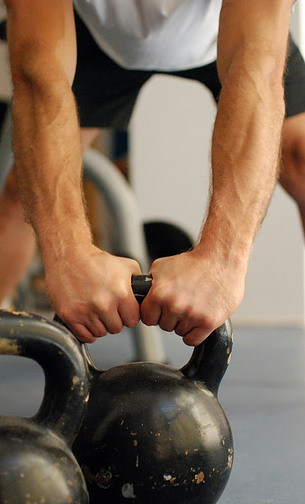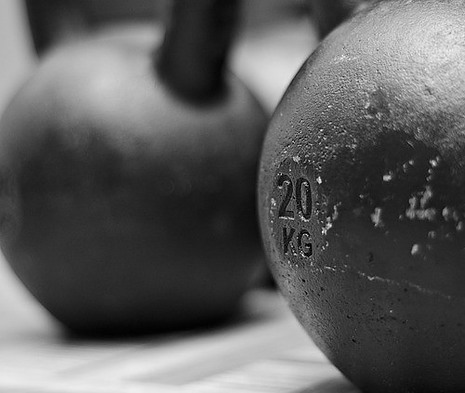 Imagine an exercise so simple that it seems like child’s play—picking up a weight and putting it down again. You might be wondering, “What’s so special about that?” Well, the kettlebell deadlift, often underestimated for its apparent simplicity, is a powerful tool for perfecting your deadlift form in general, as well as strengthening and protecting your back. Being able to pick up a heavy object and put it down, in a safe manner, is foundational to much of fitness. IN this post, we’ll explore why the deadlift (with a kettlebell in particular) is a foundational functional movement, its advantages, and provide you with step-by-step instructions to perform this exercise. By the end, you’ll be well-equipped to add this foundational exercise to your workout- whether as a warm-up for other movements, or as a main movement itself.
Imagine an exercise so simple that it seems like child’s play—picking up a weight and putting it down again. You might be wondering, “What’s so special about that?” Well, the kettlebell deadlift, often underestimated for its apparent simplicity, is a powerful tool for perfecting your deadlift form in general, as well as strengthening and protecting your back. Being able to pick up a heavy object and put it down, in a safe manner, is foundational to much of fitness. IN this post, we’ll explore why the deadlift (with a kettlebell in particular) is a foundational functional movement, its advantages, and provide you with step-by-step instructions to perform this exercise. By the end, you’ll be well-equipped to add this foundational exercise to your workout- whether as a warm-up for other movements, or as a main movement itself.
Why is the Kettlebell Deadlift a Strong Foundational Movement?
At first, the kettlebell deadlift may seem like an overly simple exercise—one that doesn’t require much skill or effort. However, beneath its apparent simplicity is a functional movement that forms the basis of many everyday activities. Here’s why it’s considered a fundamental and functional exercise:
Functionally Beneficial: The kettlebell deadlift mimics one of the most common movements in daily life: picking objects up from the ground. Whether you’re lifting groceries, luggage, or your child, this movement is essential. The more you master variations of the kettlebell deadlift (e.g. single arm, suitcase, single-leg), the more able you will be to properly pick up objects of various weights with good form. Mastering the deadlift ensures doing this basic movement safely and efficiently.
Full-Body Engagement: While the kettlebell deadlift primarily targets the lower back, lats, and legs (with the majority of the work landing on the hamstrings), in truth the movement engages multiple muscle groups simultaneously. It engages the whole or our body, coordinating our muscles to work in synergy, so the brunt of the load doesn’t inappropriately fall on one group, which aggravates the risk of injury. By engaging a bulk of our musculature at once, the deadlift builds overall strength throughout our body.
Spine Health: Learning to hinge at the hips and maintain a neutral spine during the kettlebell deadlift reinforces good posture and reduces the risk of back injuries. This makes it not only an exercise for strength but also for spine health, as learning how to hip hinge (and letting it become second nature) protects our spine throughout any movement where we need to bend down.
Improved Hip Mobility: Because most of the manner in which we work promotes a sedentary lifestyle in a seated position, many often find themselves with weak hip flexors/extensors and a lack of mobility overall in the hips. The kettlebell deadlift helps improve hip flexibility and mobility by promoting proper hip hinge mechanics, and working the hips through that range of motion.
Strength Transfer: Mastering the kettlebell deadlift lays the groundwork for more advanced lifts and exercises. It’s a prerequisite for movements like the kettlebell swing, clean, and snatch, making it an essential skill for anyone interested in kettlebell training. It’s even a great exercise to practice ensuring proper deadlift mechanics for carryover to the barbell deadlift, as the closer grip necessitated by the kettlebell handle (the “horns”), helps us to feel when we squeeze our lats into proper engagement.
The Benefits of the Kettlebell Deadlift
So how can the kettlebell deadlift provide us with some benefits to our overall health, strength, and fitness?
Strength Development: The primary benefit is, of course, building strength. Just like the standard conventional deadlift with a barbell, it targets some of the largest muscle groups in the body, leading to increased overall strength and power.
Muscle Endurance: Repeatedly performing deadlifts with kettlebells builds muscle endurance, allowing you to sustain effort over longer periods. This is especially beneficial for athletes in sports like rugby, football, and martial arts.
Core Stability: The exercise engages the core muscles to stabilize the spine, promoting better balance and overall stability.
Injury Prevention: By teaching proper lifting mechanics and promoting spine health, the kettlebell deadlift helps reduce the risk of lower back injuries, a common concern in many strength-training exercises.
Functional Fitness: As mentioned earlier, the deadlift is a practical, real-world movement. Mastering it improves your ability to handle everyday activities safely and effectively.
Minimalist Fitness: The kettlebell deadlift can be performed with minimal equipment, making it a convenient exercise for those with busy schedules or limited access to a gym.
Versatility: You can modify the kettlebell deadlift to suit your fitness level and goals, whether you’re a beginner or an advanced athlete. As you continue to progress further, the light weight of the kettlebell relative to the standard conventional barbell deadlift allows for a variety of more advanced kettlebell deadlift variations, including the unique and vastly beneficial suitcase deadlift.
Performing the Kettlebell Deadlift:
A Step-by-Step Tutorial
Okay, it’s basic, but it’s very beneficial! So how do we perform the kettlebell deadlift?
*Note: Before you begin, ensure you have an appropriate kettlebell weight for your fitness level. If you’re new to this exercise, start with a lighter kettlebell to learn the proper form.*
Step 1: Set Up
1. Place the kettlebell on the ground in front of you.
2. Stand with your feet shoulder-width apart, with your toes pointing slightly outward.
3. Position the kettlebell so it’s centered between your feet.
4. Bend at your hips, not your waist, to reach for the kettlebell. Keep your back straight and chest up.
5. Engage your lats by squeezing your shoulder blades back and down. Try to imagine you are squeezing a tennis ball between your lower shoulder blades, and pinching a piece of paper beneath each of your armpits. You should feel your lats really turn on!
6. As you hinge at the hips, push your buttocks back as if you’re closing a car door with your rear end. This maintains a neutral spine.
Step 3: Grip
7. Reach for the kettlebell with both hands, keeping them close to your shins.
8. Grip the handle firmly with your palms facing your body (pronated grip). You’ll have just enough space on the handle for both of your hands
Step 4: Lift
9. Take a deep breath into your belly and brace your core.
10. Begin to straighten your hips and knees simultaneously to lift the kettlebell off the ground.
11. Maintain a strong, straight back throughout the movement.
12. Stand tall, fully extending your hips and knees, and bringing the kettlebell to hip height.
Step 5: Descend
13. To lower the kettlebell, initiate the movement by pushing your hips back, just like in the initial hinge.
14. Keep the kettlebell close to your body as you descend.
15. Once the kettlebell touches the ground, you’ve completed one repetition.
16. Rinse and repeat!
It may seem like a lot of steps, but I admittedly put an extra amount of detail in the step just to ensure we understand how much goes into lifting with proper form. If you want a simple breakdown, it’s this: Engage your lats, brace your core, Hip hinge down and up while squeezing your glutes!
The kettlebell deadlift may appear unassuming, but it’s a fundamental movement that unlocks a world of strength, functionality, and fitness. It’s not just about picking something up and putting it down; it’s about mastering a skill that builds as the first step of many kettlebell movements. Master the kettlebell deadlift with some heavy weight, and you’ll feel confident as you step in front of any kettlebell!
Mastered it already? Check out these top 5 advanced kettlebell deadlift variations for even more kettlebell gains! Please reach out if you have any questions, and take a look around the site for more great kettlebell content! Till then…
Happy Kettlebelling,
Mark